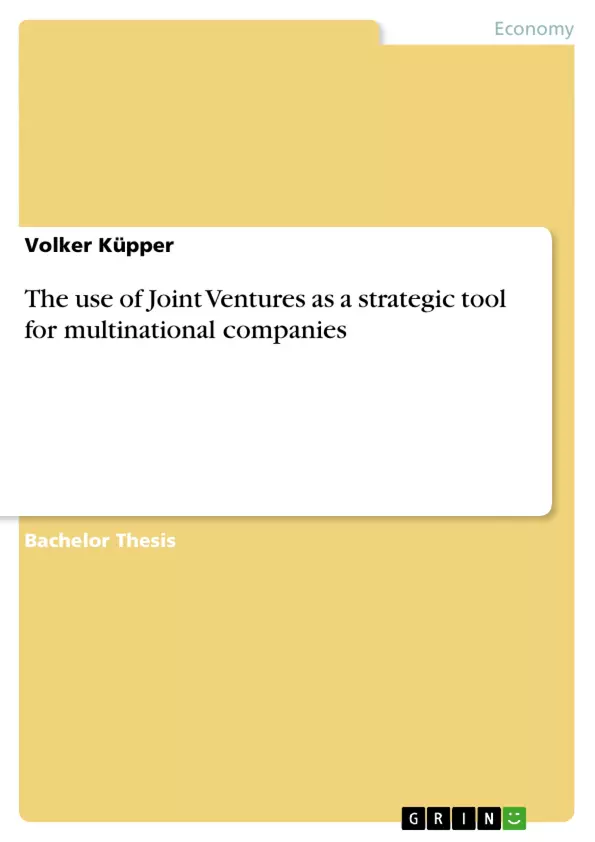The dissertation covers the field of competitive collaboration by focusing on Joint Ventures. It identifies the strategic usefulness for multinational companies by evaluating critical success factors and pre-conditions. Due to increasing pressure from the business environment the trend of competitive collaboration has accelerated. In this context, Joint Ventures were identified as a potential field of investigation. The apparent contradiction of cooperating with a competitor evoked the discussion of potential risks. It was questionable whether
companies do so loose some of its sovereignty. This question created the incentive to identify essential requirements when forming a Joint Venture. By analysing the available literature, Joint Ventures were identified as a strategic tool for multinational companies to achieve competitive advantage. It was outlined that the risks that come along with competitive collaboration can be minimized if the preconditions of Joint Venture creation are considered adequately. Moreover, the analysis clarified the need for explicit responsibilities for each sub-process when forming a Joint Venture. The analysis of a specific case highlighted the essential learning potential from past cooperations in order to succeed over the long term.
Finally, the analysis showed that well structured and re-arranged measures leverage the benefits of competitive collaboration. It was identified, that a loss of sovereignty only occurs if the alliance is managed poorly. It was recommended that a three stage model, including the sub-processes “alliance
planning”, “partner selection” and “alliance structure and management”, should be implemented to generalise the process of alliance management. Moreover, setting a focus on strategic and cultural compatibility between the partners was evaluated as
being important to maintain the health of the alliance over the long term. The dissertation outlined that especially multinational companies, whose strategy considerably depends on alliance partners, should strive to institutionalise the
alliance management. Finally it was recommended, that gatekeepers should be implemented rather than abolished. A controlled flow of information and the importance of keeping each company’s ompetitive advantage were seen as being essential.
Inhaltsverzeichnis (Table of Contents)
- Introduction
- Aims
- Limitations
- Literature review of Strategic Alliances and Joint Ventures
- Choosing a partner - The collaboration with a competitor
- Principles for competitive collaboration
- Durability of the cooperation
- Outcome when collaborating with a competitor
- Strategic Alliances
- SAs as a strategy for multinational businesses
- Benefits of Strategic Alliances
- Costs and risks when forming a Strategic Alliance
- The need for a new management style
- Range of Strategic Alliances
- The role of Joint Ventures
- Structuring the Joint Venture for a multinational strategy
- The Joint Venture in a multinational perspective
- A definition of Joint Ventures
- The process of structuring a Joint Ventures
- The Joint Venture checklist
- Principles and reasons for Joint Venture creation
- Risks and costs of Joint Ventures
- Concluding JVS
- Methodology
- Research methods
Zielsetzung und Themenschwerpunkte (Objectives and Key Themes)
This dissertation aims to examine the strategic use of joint ventures for multinational companies by evaluating critical success factors and pre-conditions. The study explores the increasing trend of competitive collaboration and analyzes the risks and benefits associated with joint ventures. The dissertation focuses on the strategic use of joint ventures as a tool to achieve competitive advantage, exploring the need for a new management style and the importance of proper alliance management.- Competitive collaboration and its strategic implications
- Joint ventures as a strategic tool for multinational companies
- Critical success factors and pre-conditions for successful joint ventures
- Risks and benefits of competitive collaboration
- The role of alliance management in ensuring the success of joint ventures
Zusammenfassung der Kapitel (Chapter Summaries)
The introduction outlines the aims and limitations of the dissertation. It focuses on the increasing trend of competitive collaboration and identifies joint ventures as a potential field of investigation. Chapter 2 provides a literature review on strategic alliances and joint ventures, discussing the principles for competitive collaboration, the durability of cooperation, and the potential risks and benefits of working with a competitor. It explores the strategic use of strategic alliances for multinational businesses and examines the specific role of joint ventures in achieving competitive advantage. Chapter 2 also delves into the process of structuring a joint venture for multinational companies, outlining the checklist and key considerations for a successful alliance. The chapter concludes with a discussion of the risks and costs of joint ventures, highlighting the importance of careful planning and management.Schlüsselwörter (Keywords)
The central keywords of the dissertation are: joint ventures, strategic alliances, competitive collaboration, multinational companies, strategic advantage, alliance management, critical success factors, pre-conditions, risks, benefits, management style. These terms reflect the primary focus of the study on the strategic use of joint ventures and the factors contributing to their success for multinational corporations.- Arbeit zitieren
- Volker Küpper (Autor:in), 2008, The use of Joint Ventures as a strategic tool for multinational companies, München, GRIN Verlag, https://www.grin.com/document/127943



